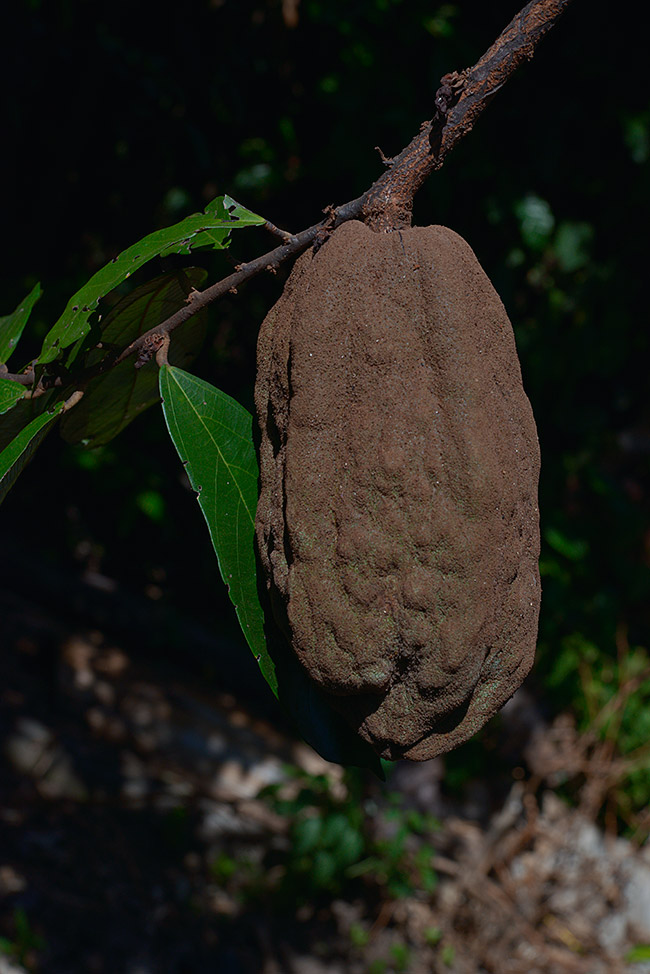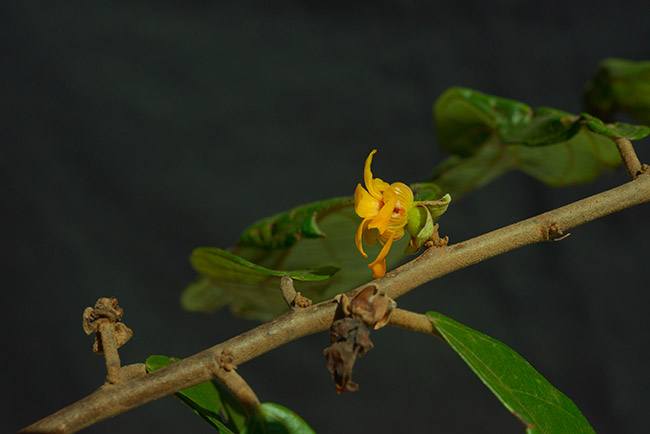Theobroma angustifolium is the "third species of cacao" for Mesoamerica
Theobroma cacao is the primary species, the source of cacao for cocoa and chocolate (now around the world).
 |
Theobroma angustifolium seed pod |
 |
Theobroma angustifolium flower |
Theobroma bicolor is the second species in Mesoamerica, but probably less than 5% the number of trees compared with Theobroma bicolor.
Now we at FLAAR have noticed the third species. This third species is so absent from most books on cacao, cocoa, and chocolate that we did not notice it until late 2014. We immediately began to drive around Guatemala to find it: almost no one had heard of it.
But botanical monographs from half a century ago listed Theobroma angustifolium as clearly present in Guatemala, so we kept looking. We criss-crossed cacao and pataxte areas, driving several thousand kilometers. Finally, though the help of Guatemalan colleagues, we found a mature tree with two flowers and a nice almost mature seed pod.
The immediate question is what are any chemical differences in the beans for making cocoa and then chocolate? What are the health benefits? What are the taste and flavor differences?
We got permission to take the seed pod back to our photo studio so we could do 3D photography, QTVR photography, and close-up photography with professional photo studio lighting. So now we can include nice photographs (as soon as our photo archive staff are back in the office).
This is our style of research: if we learn about something through a botanical monograph or article, we prefer to go out into the fields, mountains, and seasonal rain forests and learn about the species in-person. Our style is to avoid just copy-and-paste from popular web sites.
Introductory Bibliography of Theobroma angustifolium, cacao silvestri
- 2012
- Phenology of flowering in cacao (Theobroma cacao) and its related species in Nigeria. African Journal of Agricultural Research Vol. 7(23), pp. 3395-3402, 19 June, 2012.
Helpful article but phenology in the eco-systems of Nigeria are not necessarily the same as eco-systems of Guatemala, much less Mexico, Belize, Honduras, etc. Even within Guatemala, many species bloom at different periods in different elevations and different rainfall patterns.
- 1964
- Cacao and its allies: a taxonomic revision of the genus Theobroma. Contr. U.S. Natl. Herb. 35:526. [as a member of section Glossopetalum; although it cites a hybrid with Theobroma cacao × T. angustifolium, apparently this was a hybrid of slow growth and of unknown fertility].
- 2011
- “Estudio agromorfológico y fisicoquímico de los ecotipos de cacao cultivados en los municipios de Izalco y Nahulingo, en el Departamento de Sonsonate en El Salvador.” Thesis. About 100 pages (final pages not numbered).
Shows dozens, scores, of varieties, including a pataxte with yellow flowers (Theobroma bicolor in Guatemala has red flowers). http://webquery.ujmd.edu.sv/siab/bvirtual/BIBLIOTECA%20VIRTUAL/TESIS/04/IAL/ADTESGE0001258.pdf
- 2001
- Mansfeld's Encyclopedia of Agricultural and Horticultural Crops. 2 volumes, 3641 pages, 291 illustrations.
Page 1581, rather weak on Theobroma angustifolium, just one paragraph.
- 1908
- Ensayo sobre las plantas usuales de Costa Rica. McQueen, Inc. Washington, D.C.
Pages 72ff.
- 1991
- Chemical Composition of Wild Theobroma Species and Their Comparison to the Cacao Bean. J. Agric. Food Chem. 39:1940.
- 1923
- Trees and Shrubs of Mexico (Oxalidaceae-Turneraceae). Contributions from the United States National Herbarium. Vol. 23, Part 3. Bulletin of the United States National Museum. Washington, D.C.
Theobroma angustifolium DC. Frodr, 1: 484. 1824.
Chiapas and Tabasco, and perhaps elsewhere. Central America.
Small tree with spreading crown, the bark smooth; leaves oblong or oblongob lanceolate, 13 to 25 cm. long, abruptly acuminate, somewhat oblique at base, green above, glabrous or nearly so, whitish beneath; flowers yellow, borne on the young branches, the clusters few-flowered; petals about 1 cm. long; fruit oval, dark chestnut or cinnamon-brown, smaller than in T, cacao. "Cushta" {El Salvador); "cacao de mico," "cacao silvestre " (Costa Rica).
This species is one of the important cacao plants of Mexico, and the notes given above under T. cacao apply in large part to it also. In Chiapas Theobroma angustifolium is the species generally grown. The region of Soconusco has long been famous for its chocolate, derived from this species, and for many years the supply for the royal family of Spain was brought from Soconusco. (Standley 1923: 808).
Not much on Theobroma angustifolium… “Small tree” is correct when compared with a conacaste or ceiba tree. And Theobroma bicolor may be taller. But the tree I saw in Guatemala had a truck of healthy circumference. The trunk was noticeably thicker than any Theobroma cacao. The foliage was thicker than T. cacao or T. bicolor. - 1991
- Flora of Guatemala. Fieldiana Botany Vol. 24, Part VI. Chicago Natural History Museum.
Pages 421 and 422 cover Theobroma angustifolium.
Theobroma angustifolium DC. Prodr. 1: 484. 1824. Cacao de Costa Rica.
Planted occasionally in the Pacific coast or bocacosta, in the tierra caliente; tending to become naturalized in moist forest near plantations; noted in Santa Rosa and Suchitepequez, and doubtless in all the Pacific coast departments, as well as in Alta Verapaz. Chiapas and Tabasco; Salvador; Costa Rica; Panama; chiefly in cultivation, scarcely known in a truly wild state.
A small tree with a spreading crown, the bark smooth; leaves on very short petioles, oblong or oblong-oblanceolate, mostly 15-25 cm. long and 10 cm. wide or narrower, abruptly acuminate, obtuse or narrowly rounded and oblique at the base, entire, green above and glabrous or nearly so, covered beneath with a minute white tomentum, the nerves usually brown; inflorescences borne in the leaf axils on the young branches, stellate-tomentulose, about equaling the petioles; flowers yellow, 2 cm. broad; fruit irregularly ovoid or obovoid, about 15 cm. long and 7-8 cm. broad, obsoletely 5-sulcate, covered with a close brownish tomentum, glabrate in age; seeds slightly larger than those of T. Cacao. Known in Salvador as "cushta" or "cacao de la India." The native region of this cacao is unknown, although Bernoulli (Neue Denkschr. Allg. Schweiz. Gesell. 24: 13. 1871), who had field experience in Central America, was inclined to believe it was native in southern Central America. In Costa Rica it is called "cacao de mico" and sometimes "cacao silvestre." The species is much planted in southwestern Mexico, especially in Chiapas, as a source of commercial cacao, and the product from Soconusco was used for many years to supply the royal family of Spain. The pulp of the fruit is edible raw, as is that of other species.
Introductory Bibliography of Theobroma angustifolium, cacao silvestri
http://es.wikipedia.org/wiki/Theobroma_angustifolium
Not much info, just a paragraph. Not a single photo. But does give the local names: cacao silvestre, cacao de mono, or cacao de montaña
www.britannica.com/EBchecked/topic/709301/Theobroma-angustifolium
Even worse than Wikipedia; no wonder encyclopaedias went bankrupt. I do not understand why an editor would put such insufficient and inadequate information with their corporate brand name all over the page.
www.eol.com is so inadequate I will spare my comments.
Web sites with helpful photographs
www.montosogardens.com/theobroma_angustifolium.htm
Several nice photos, including fruit pod, seeds, and nice photo of the beautiful flower. The white pulp surrounding the brownish seeds reminds me of normal cacao.
www.plantnames.unimelb.edu.au/Sorting/Theobroma.html
Nice inventory of plant names in many languages for different species of Theobroma.
First posted Jan. 9, 2015.